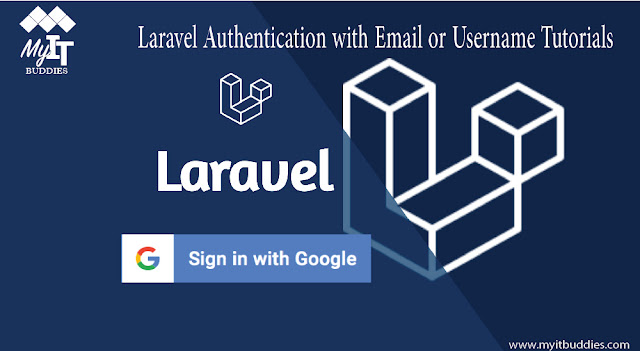Let's start Laravel Authentication with Email or Username Tutorial.I'll give you a simple Laravel 6 login solution with username or email for authentication. It is easy to log into the Laravel 6 application with username and email address authentication.
At some point we need to create a login page with a username or email address to login. It is a great feature if you have it on your website as it is really easy to remind someone of your customer. Customer If you have forgotten the email, you have a user name. So it really helps.
In Laravel 6 Authentication with Email or Username Tutorial I will explain step by step how you can configure the login with username or email. So let's follow the next steps.
Step 1: Install Laravel 6
composer create-project --prefer-dist laravel/laravel blog
Step 2: Install Laravel User Interface
There are a few steps you need to take to authenticate in your Laravel 6 application.
You must first install the Laravel / UI package as shown below:
composer require laravel/ui
Step 3: Generate an authentication framework
Here we have to generate authentication frameworks in Laravel 6 with the command laravel ui. Then we generate with the following command:
php artisan ui bootstrap --auth
Now you need to run the npm command, otherwise you won't see a better design of the login and registration page.
Install NPM:
npm install
Run NPM:
npm run dev
Step 4: Add Username Column
Now add a new column username to your user table so that you can easily update your migration as given below.
migration
<?php use Illuminate\Database\Migrations\Migration; use Illuminate\Database\Schema\Blueprint; use Illuminate\Support\Facades\Schema; class CreateUsersTable extends Migration { /** * Run the migrations. * * @return void */ public function up() { Schema::create('users', function (Blueprint $table) { $table->bigIncrements('id'); $table->string('name'); $table->string('email'); $table->string('username')->nullable(); $table->timestamp('email_verified_at')->nullable(); $table->boolean('is_admin')->nullable(); $table->string('password'); $table->rememberToken(); $table->timestamps(); }); } /** * Reverse the migrations. * * @return void */ public function down() { Schema::dropIfExists('users'); } }
Now you can start the migration
php artisan migrate
Step 5: Update Login View
Laravel has created a standard logon blade file. We need to add the comman username field and delete the email field. So let's update as follows:
resources/views/auth/login.blade.php
.... <div class="form-group row"> <label for="username" class="col-md-4 col-form-label text-md-right">Username Or Email</label> <div class="col-md-6"> <input id="username" type="username" class="form-control @error('username') is-invalid @enderror" name="username" value="{{ old('username') }}" required autofocus> @error('username') <span class="invalid-feedback" role="alert"> <strong>{{ $message }}</strong> </span> @enderror </div> </div> ....
Step 6: Overwrite Login method
Now we have to overwrite the login with the LoginController file. So let's add the login controller as shown below:
app/Http/Controllers/Auth/LoginController.php
<?php namespace App\Http\Controllers\Auth; use App\Http\Controllers\Controller; use Illuminate\Foundation\Auth\AuthenticatesUsers; use Illuminate\Http\Request; class LoginController extends Controller { use AuthenticatesUsers; protected $redirectTo = '/home'; /** * Create a new controller instance. * * @return void */ public function __construct() { $this->middleware('guest')->except('logout'); } /** * Create a new controller instance. * * @return void */ public function login(Request $request) { $input = $request->all(); $this->validate($request, [ 'username' => 'required', 'password' => 'required', ]); $fieldType = filter_var($request->username, FILTER_VALIDATE_EMAIL) ? 'email' : 'username'; if(auth()->attempt(array($fieldType => $input['username'], 'password' => $input['password']))) { return redirect()->route('home'); }else{ return redirect()->route('login') ->with('error','Email-Address And Password Are Wrong.'); } } }
You can add some dummy records to your user table.
Now you can run your project.
I hope this Tutorial of Laravel Authentication with Email or Username could help you ...
Thanks.






0 comments:
Post a Comment
Please don't enter any spam link in the comment box.